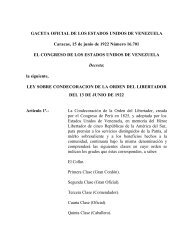Transverse waves on a string - People.fas.harvard.edu
Transverse waves on a string - People.fas.harvard.edu
Transverse waves on a string - People.fas.harvard.edu
Create successful ePaper yourself
Turn your PDF publications into a flip-book with our unique Google optimized e-Paper software.
6 CHAPTER 4. TRANSVERSE WAVES ON A STRING<br />
This equati<strong>on</strong> says that for a given value of k, we can decompose the functi<strong>on</strong> C(k, t) into<br />
its eiωt Fourier comp<strong>on</strong>ents. Plugging this expressi<strong>on</strong> for C(k, t) into Eq. (13) gives<br />
∞ ∞<br />
<br />
ψ(x, t) =<br />
=<br />
−∞<br />
β(k, ω)e<br />
−∞<br />
iωt dω<br />
e ikx dk<br />
∞ ∞<br />
β(k, ω)e i(kx+ωt) dk dω. (16)<br />
−∞<br />
−∞<br />
This is a general result for any functi<strong>on</strong> of two variables; it has nothing to do with the wave<br />
equati<strong>on</strong> in Eq. (4). This result basically says that we can just take the Fourier transform<br />
in each dimensi<strong>on</strong> separately.<br />
Let’s now apply this general result to the problem at hand. That is, let’s plug the above<br />
expressi<strong>on</strong> for ψ(x, t) into Eq. (4) and see what it tells us. We will find that ω must be<br />
equal to ck. The functi<strong>on</strong> β(k, ω) is a c<strong>on</strong>stant as far as the t and x derivatives in Eq. (4)<br />
are c<strong>on</strong>cerned, so we obtain<br />
0 = ∂2ψ(x, t)<br />
∂t2 ∂x2 ∞ ∞<br />
=<br />
β(k, ω)<br />
−∞ −∞<br />
∞ ∞<br />
=<br />
−∞<br />
−∞<br />
− c 2 ∂2 ψ(x, t)<br />
2 i(kx+ωt) ∂ e<br />
− c 2 ∂2ei(kx+ωt) ∂t 2<br />
β(k, ω)e i(kx+ωt)<br />
− ω 2 − c 2 (−k 2 )<br />
∂x2 <br />
dk dω<br />
<br />
dk dω. (17)<br />
Since the e i(kx+ωt) exp<strong>on</strong>entials here are linearly independent functi<strong>on</strong>s, the <strong>on</strong>ly way that<br />
this sum can be zero for all x and t is if the coefficient of each separate e i(kx+ωt) term is<br />
zero. That is,<br />
β(k, ω)(ω 2 − c 2 k 2 ) = 0 (18)<br />
for all values of k and ω. 2 There are two ways for this product to be zero. First, we can<br />
have β(k, ω) = 0 for particular values of k and ω. This certainly works, but since β(k, ω)<br />
indicates how much of ψ(x, t) is made up of e i(kx+ωt) for these particular values of k and ω,<br />
the β(k, ω) = 0 statement tells us that this particular e i(kx+ωt) exp<strong>on</strong>ential doesn’t appear<br />
in ψ(x, t). So we d<strong>on</strong>’t care about how ω and k are related.<br />
The other way for Eq. (18) to be zero is if ω 2 − c 2 k 2 = 0. That is, ω = ±ck, as we<br />
wanted to show. We therefore see that if β(k, ω) is n<strong>on</strong>zero for particular values of k and ω<br />
(that is, if e i(kx+ωt) appears in ψ(x, t)), then ω must be equal to ±ck, if we want the wave<br />
equati<strong>on</strong> to be satisfied.<br />
4.2 Reflecti<strong>on</strong> and transmissi<strong>on</strong><br />
4.2.1 Applying the boundary c<strong>on</strong>diti<strong>on</strong>s<br />
Instead of an infinite uniform <strong>string</strong>, let’s now c<strong>on</strong>sider an infinite <strong>string</strong> with density µ1<br />
for −∞ < x < 0 and µ2 for 0 < x < ∞. Although the density isn’t uniform, the tensi<strong>on</strong><br />
is still uniform throughout the entire <strong>string</strong>, because otherwise there would be a n<strong>on</strong>zero<br />
horiz<strong>on</strong>tal accelerati<strong>on</strong> somewhere.<br />
Assume that a wave of the form ψi(x, t) = fi(x − v1t) (the “i” here is for “incident”)<br />
starts off far to the left and heads rightward toward x = 0. It turns out that it will be much<br />
2 Alternatively, Eq. (17) says that β(k, ω)(ω 2 − c 2 k 2 ) is the 2-D Fourier transform of zero. So it must be<br />
zero, because it can be found from the 2-D inverse-transform relati<strong>on</strong>s analogous to Eq. (3.43), with a zero<br />
appearing in the integrand.

















